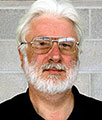Absence by Dirk de Bruyn |
 |
My history is a history of absence that
is: absent. I am caught on this mobius strip in my relations to Australian cinema. How and where do I or any of my
colleagues exist here? What is seen? What is known? In my past
‘in-articulations’ I have placed myself ‘outside the outside’ or in some kind
of negative cultural space. This I have learnt to understand as some kind of
aesthetic and political processing of my parents' migrant position, my father’s
mental illness, early death and related family traumas. Having seen
experimental work more recently from other European countries and Asia through international
travel, I also wonder whether my dependence of North American and British alternative
film histories has been a productive project. This ‘English’ history settles my
Australian film history as an absence.
Instead I find something of interest in
Serbian formalism, Croatia’s Tomislav Gotovac or Ivan Ladislav Galeta’s TV Ping/Pong (1975/78), Mihovil Pansini’s ‘anti-films’, his Scusa Signorina (1963), Dvoriste (1963), or the erased K3 (cloudless sky) (1963). There was something personal and hard edged political in this
minimalism. An exhibition of post-war art from 1945-1968, pre-occupied with
trauma, containing numerous moving image works at ZKM in Karlsruhe, Germany in
2016, whose dysfunction also caught my eye and ear.
I remain interested in how objects, ideas
and gestures appear and disappear. I am particularly attracted to that instance
just before or as they do. I am interested how that instance is constructed as
a denial, as a trace, as an image, as a sound, and then wrapped into a tight incoherent
ball.
I am coming to terms with a kernel of
insight, that there is something unique, personal and artisanal in Australian
experimental moving image works that has not been called out yet. This tight
ball is an uncanny mixture of brutality and honesty. There is something more
direct and autobiographical in work from the 1970s and 1980s, particularly from
the Melbourne I knew, that sets it apart from the formalisms developed
elsewhere during this period. Frank Lovece’s Te Possino Ammazza (1987) or Lee Smith’s fragile Tin Jan Istra (1994) are later
high points in this personal aesthetic. I have been approaching this difference
by trying to write seriously about the forgotten work of some of my
contemporaries; Michael Lee’s feature length The Mystical Rose (1976), Neil Taylor’s flip book animations,
Lynsey Martin’s formalism and Noel Richards hybrid analog-digital One Complete Revolution (1989). That is as
far I have got. So far.
On top of all this I recently had a
number of hard drives stolen, of incomplete work. All gone. This sleight of hand now invades my thinking every day. My body deals with it
as the termination of a decade-long intimate relationship with digital film-making.
I get prompted back into mourning these lost works when I
see an object, a location, a place which I previously filmed off-the-cuff in my
‘native’ Melbourne. I then have to remember and walk through the knowledge that these shots, this sequence, this intimacy of images has been materially erased. Unrecoverable. Here is another
layer of disappearance that I get to witness. Lucky me. I have learnt to do this in an instant, the smallest packet of time. I have had
to do this before with other ‘obsessions’. We all have. As with the bullied Racisms
and Sexisms that survive and thrive in inner city living, like my mourning, such
ideologies play out in small concussions of self-recognition. They promenade
through daily life. These slight demeaning moments and events are the most effective
means of control operating on all our bodies. An ideological
nudge on Facebook. A look away on the street. An unspoken compliment. There are new duplicities constantly
being invented in academic life. Many of us struggle, get weighed down by such an
inexorable flow that bypasses our thinking and goes straight for the body.
In mainstream film I am in awe of those
violent concussions that punctuate Warwick Thornton’s Samson and Delilah (2009). What essential Australian road has this
artist travelled? Let me stand in his shadow. This film’s brutal biographic
violence says more than any moralising tale about what survival means in Oz.
Direct and to the point. It is easiest to stutter this history. Break it down
into piles of dust. So, just leave me alone to re-enact the moans my mother
uttered, and the pain on my father’s face. I don’t need any money, just time.
|
Published March 27, 2018. © Dirk de Bruyn, February 2018
|